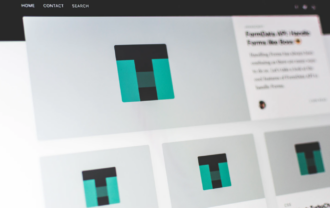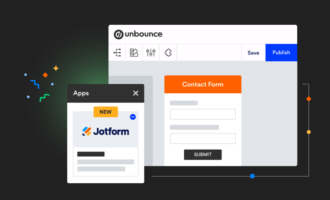Tips to optimize a landing page
- Provide incentive to drive conversions
- Identify your offer
- Perfect your landing page copy
- Focus on the landing page design
- Decrease your page load time
- Include a clear call to action
- Build trust in your offer
- Create an easy-to-use form
- Improve your thank-you page
- Optimize your landing page for SEO
- Use an exit popup
- A/B test your landing page
Landing pages are an essential element of your online marketing strategy and marketing campaigns. By helping you capture contact information from website visitors, a landing page builds your marketing lists and moves leads into your sales funnel. But if a landing page isn’t converting like it should — that is, visitors aren’t sharing their contact information — you’re missing out on valuable leads.
High-converting landing pages have some key elements in common, such as a clear call to action (CTA) and an appealing visual design. While you don’t necessarily have to redesign an entire landing page, optimizing its current elements can help increase your conversion rate and your page’s overall performance.
By optimizing your landing page to gather more leads, you’ll be able to use those leads in your marketing funnels to drive sales. When your landing page is optimized to drive conversions, you’ll also see increased value from any paid advertising you’re doing (like pay-per-click) to drive traffic to your landing page.
Landing page optimization basics
Landing page optimization refers to the process of improving each element of your landing page with the goal of increasing conversion. When optimizing a page, you’ll examine and improve these elements, then use methods like A/B testing to verify that the changes you’re making are actually improving your conversion rate. By repeating the process and working your way through each of the elements, you can ensure you’re getting the best value out of your landing page.
12 tips for how to optimize a landing page
The following tips will guide you through the process of optimizing your landing page, step by step.
1. Provide incentive to drive conversions
If your current landing page isn’t converting well, you might also want to reexamine the incentive that you’re providing to entice people to share their contact information with you. In other words, is your offer really good enough to get your site visitors to take the time to sign up?
There are many potential offers you can make to your audience. Access to a webinar hosted by well-known leaders in the industry, a download of gated content (like an e-book full of valuable information), enrollment in a contest offering a big prize, and even a hefty discount on your services or products all make appealing offers.
You may want to test out multiple types of offers while keeping the rest of your landing page nearly the same. Your audience may respond differently to different offer types and to offers that contain different content. For example, try out different e-book and webinar topics to see which appeals most to your audience.
Don’t forget that you have an excellent way to find out just what your audience most wants — you can ask them. Poll your current customers and social media followers to learn which topics and types of content they’d most like to receive. Ask your audience about the types of problems they want to solve, and follow up with those who’ve taken advantage of past offers to find out what they most appreciated and what they’d change about the experience.
2. Identify your offer
Landing pages exist to get your website visitors to take some sort of action. You need to identify your offer and make sure that the offer is clear to your page visitors.
For example, you might want your visitors to sign up for your newsletter, download an e-book, or take advantage of some other sort of offer. Once you’ve defined this offer, it’s important to make sure that the copy and your call to action are consistent in promoting the offer.
3. Perfect your landing page copy
Your landing page copy needs to be engaging, clear, and compelling to your audience. It can help identify your audience’s pain points and highlight how your offer will address those pain points.
It’s important that your copy really focuses on the value of your offer. Don’t assume that everyone understands its value. Instead, spell it out and remind your audience multiple times why the offer is so beneficial to them.
This is particularly important when you’re writing longer copy; you need to establish the value early on and then continue reminding your readers of it. If possible, find ways to increase the value as you bring visitors down the page, whether by adding in more freebies or by offering a lower price point for customers willing to take advantage of the offer immediately.
When writing your copy, make sure that the voice reflects your brand. If your branding is lighthearted and fun, your copy needs to reflect that. Similarly, if your business has a more formal tone, then your landing page isn’t the place to suddenly switch things up and take a playful approach to your copy.
As you write your copy, check how it appears on the site. Short sentences and short paragraphs with lots of white space are easier to read, and they can help lead your site visitors down the page. Also, be sure to use headings and bullet points to keep the copy scannable — even though you put a lot of time and effort into creating your copy, your visitors are likely to just scan most of it.
It can be difficult to craft compelling landing page copy, and if you’re struggling with this element, consider hiring a copywriter who has a proven track record of writing high-converting landing pages.
4. Focus on the landing page design
Your page’s design may also be an area for improvement. Like your copy, your landing page design should reflect your branding — you want your audience to be able to recognize your business simply by looking at your landing page.
But make sure you don’t go too wild with colors, fonts, and graphics. Focus on a clean, easily scannable design that doesn’t overwhelm visitors. While photos and graphics are excellent if they make your page more compelling, keep in mind that adding too many of these landing page elements will slow down your page load time, which can result in lost leads.
Be cautious about using stock photos too. It’s always better to use photos featuring actual customers — or even better, actual photos of your products in use. Investing in quality photography can help drive conversions and build trust in your products or services.
5. Decrease your page load time
In today’s world of instant gratification, a slow-loading page can increase your bounce rate. Optimizing your images for the web, compressing your content, and fine-tuning your caching can all help improve your page load time.
6. Include a clear call to action
Your call-to-action button plays an important role in guiding site visitors through the conversion process. Your CTA needs to be straightforward and easily understood. CTAs like “Download your free e-book now” or “Sign up for this special offer now” tend to work well.
Turn your CTA into an eye-catching CTA button. The button needs to look clickable so visitors understand that you expect them to click on it. Make sure the button is large, and use a color that makes it stand out.
Depending on the length of your landing page, you may want to include your CTA button multiple times throughout the page. Including the button higher up in the page means that visitors who already know they want to take advantage of the offer don’t have to scroll all the way to the bottom. You don’t want any visitors to have to search for the option to sign up — instead, make it easy for them, and give them multiple chances to fill out your form.
7. Build trust in your offer
Depending on what your offer is, you may want to include testimonials and case studies to build trust in it. This is particularly important when you’re looking for your potential customers to make a purchase.
Gather these testimonials and case studies from customers who’ve already used your product or service. Be sure to include direct quotes from the customers, in addition to their photos and names. Include multiple case studies and testimonials to demonstrate that your product or service works and offers real value.
8. Create an easy-to-use form
It’s also important to focus on the form that your audience will use to sign up for your offer. Your CTA button should direct your audience straight to this form, and it’s essential that the form is easy to use.
When designing the form, only include form fields that are absolutely necessary. For a special offer like a free e-book download or newsletter subscription, you may only need the subscriber’s first name and email address.
If the special offer is a purchase, then you’ll need more information, but you should still make the form as easy to complete as possible. Be sure that you accept multiple payment methods, like PayPal and major credit cards.
You can use Jotform to easily create custom forms and embed them into your site. With Jotform’s templates, you can create everything from a basic newsletter subscription form to a purchase form. Jotform automatically collects subscriber data into Jotform Tables, and you can then use this spreadsheet data for your digital marketing.
9. Improve your thank-you page
When you first developed your landing page, did you create a generic thank-you message to display when someone submits their contact information? Did you include a call to action in the thank-you message? If not, you missed out on a valuable opportunity.
Revisit your thank-you page and make it work harder for your landing page. Include an email address and ask your followers to send you their thoughts on the webinar or e-book they’ve downloaded, then include their feedback as testimonials on the page. Or, ask them to follow your business on social media.
Give your followers something more to do so their experience doesn’t end with their receipt of your offer.
10. Optimize your landing page for SEO
While you can drive your target audience to your landing page with online ads, optimizing your landing page for SEO will also let you take advantage of organic search. Do some keyword research (if you haven’t already) and incorporate those keywords into your page.
If you did initially optimize your page for SEO, revisit that work. Repeat your keyword research to see if there are additional keywords that you should be ranking for, and update your page to make sure that you’re still taking advantage of those visitors you’ll attract through organic search.
11. Use an exit popup
Adding an exit popup to your landing page may help you capture those visitors who are about to leave your page without converting. An exit popup gives you a chance to grab their attention one more time. It’s the perfect place to include an additional freebie or other incentive — such as a steep discount — to drive visitors back to the page and encourage them to complete the signup process.
12. A/B test your landing page
Once you have an optimized landing page, you’re really only working with a first draft. Now it’s time to change different elements, A/B test the page, and see how you can improve on its conversions and performance.
Experiment with different headlines, form lengths, offers, and more. Each of these small elements can contribute to conversions, and when you find the right balance, you’ll be making the most of the money you’re putting into advertising and marketing.
Keep experimenting
There are many other elements you can test in addition to those listed above. The location of your page elements, different headlines, different page length, and even your navigation menus may all affect conversions.
Conversion rate optimization is an ongoing process, and there’s almost always room for improvement. When you optimize your landing page, resist the temptation to change everything at once, unless you know that you’ve made some major mistakes and need to address those issues.
Instead, if you change just a couple of elements at a time, you’ll be able to test the landing page and see how well those changes increase conversions. Optimizing conversion rates takes work and patience, but it can pay off by transforming your landing page into a powerful marketing tool.
Photo by Sergey Zolkin on Unsplash









































































Send Comment: